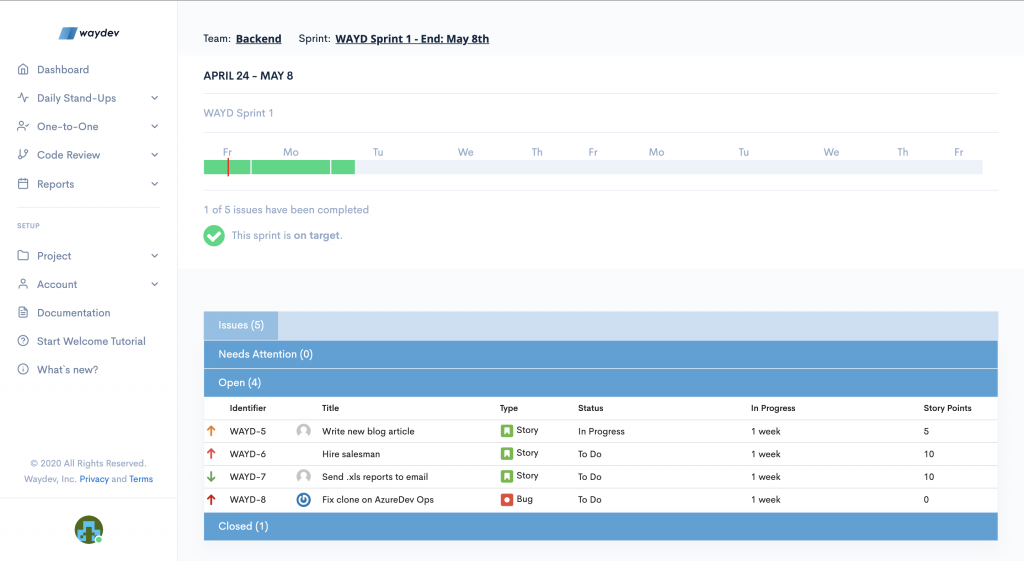How does it help you
By connecting your Jira account to Waydev, you can visualize sprint risk, see if your team over capacity, or if your sprint is falling behind. Learn how to execute sprints better. The Sprints feature, which can be enabled by connecting your Jira account, helps engineering managers who struggle with planning work and executing their sprints.

How to integrate Jira into Waydev
Step 1: Navigate to Atlassian’s API Token Manager, and click Create API token.
Step 2: Choose a label for your API token, and click Create.
Step 3: Copy the generated API token.
Step 4: In the Waydev app, navigate to Project -> Integrations.
Step 5: Select Jira, fill in the modal your Jira login email, your personal access token, and your Jira URL, and click Test connection.
Step 6: Navigate to Project -> Ticket Projects.
Step 7: Select the projects you want to process, then click Save Project. If you create new projects in Jira, you need to click the Refresh Repositories button to add them to the Ticket Projects page.
Step 8: Navigate to Project -> Engineers.
Step 9: Select the All contributors list on the left side of the Engineers page. Select the accounts that belong to the same engineer using the checkboxes on the left side. Merge the accounts by clicking the Merge button on the right side of the page. Done!
About Jira
Jira is an issue tracking tool that helps teams plan, manage, and report on their work.
Products and apps built on top of the Jira platform help teams plan, assign, track, report and manage work. The Jira platform brings teams together for everything from agile software development and customer support to managing shopping lists and family chores.
Three products are built on the Jira platform: Jira Software, Jira Service Desk, and Jira Core. Each product comes with built-in templates for different use cases and integrates seamlessly, so teams across organizations can work better together.
Key terms to know
Issues
A Jira ‘issue’ refers to a single work item of any type or size that is tracked from creation to completion. For example, an issue could be a feature being developed by a software team, a to-do item for a marketing team, or a contract that needs to be written by a legal team.
Tip: Other commonly used terms for issues are ‘requests’, ‘tickets’ or ‘tasks’. We recommend using ‘issues’ to help your team stay on the same page when working across the Jira product family.
Projects
A project is, quite simply, a collection of issues that are held in common by purpose or context. Issues grouped into projects can be configured in a variety of ways, ranging from visibility restrictions to available workflows.
Jira Software projects are flexible working spaces that allow you to group like issues by team, business unit, product, or stream of work. Projects don’t need to be tied to the same delivery date. For example, if you group your issues by team, you could have a marketing project, a development project, and a legal project, all of which would track ongoing work of those particular teams. Every issue would be represented by an issue keys (specific to a project) and an issue number, i.e. MKT-13, DEV-4, LEG-1.
Workflows
Workflows represent the sequential path an issues takes from creation to completion. A basic workflow might look something like this:
In this case, Open, Done, and the labels in between represent the status an issue can take, while the arrows represent potential transitions from one status to another. Workflows can be simple or complex, with conditions, triggers, validators and post functions. We’ll dive deeper into these advanced configurations later in this guide. For now, it is recommended for novice Jira Software admins to keep their workflows as simple as possible, until business needs determine the requirements for complex workflow configurations.
Agile
Agile is not a Jira Software-specific term. It’s a work philosophy that originated in the software development field and has since expanded to a variety of other industries. While we won’t belabor the definition here (there are great resources for that!), agile emphasizes an iterative approach to work informed by customer feedback where delivery occurs incrementally and continuously. The ideal agile team can move quickly and adapt to changing requirements without missing much of a beat.
So why are we bringing up agile here? Because Jira Software has major feature sets designed particularly for agile, including scrum or kanban. So, when you see terms like boards, estimation, or cards, it’s time to start thinking how agile fits into your work practice.
It’s important to note that because agile is a philosophy and a culture of work, simply using Jira Software won’t make your team truly agile. That said, it is a tool built to help your team get there.
😍 You May Also Like: 4 Safe Core Values: Scaled Agile Framework | Waydev 🔥








